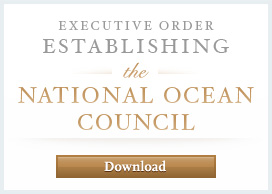Strategic Action Plans
The National Policy for the Stewardship of the Ocean, our Coasts, and the Great Lakes prioritizes nine objectives to address some of the most pressing challenges facing these precious resources. The National Ocean Council is overseeing development of strategic action plans for each of the nine objectives. As a first step the National Ocean Council has released nine strategic action plan outlines for public review during National Oceans Month.
Writing teams composed of representatives from the National Ocean Council agencies developed the strategic action plan outlines. The purpose of the outlines is to provide an initial view as to how Federal agencies might address the priority objectives as described in the National Ocean Policy. They are preliminary documents that constitute an important but interim step toward completion of the strategic action plans. The outlines, by design, are draft products that serve as an early and valuable point in the plan development process for focusing public and stakeholder input.
These outlines were drafted with input from the public. The outlines were informed by the comments received during our initial scoping period that closed on April 29. Click here to read comments on the development of strategic action plans content outlines.
Click here to read the strategic action plan outline preface.
The National Ocean Council held a month long public comment period from June 2 to July 2, 2011 to solicit input on the strategic action plan content outlines. Click here to read the comments on the outlines.
Read the Strategic Action Plan Content Outlines for the following nine priority objectives:
1. Ecosystem-Based Management: Adopt ecosystem-based management as a foundational principle for the comprehensive management of the ocean, our coasts, and the Great Lakes.
2. Coastal and Marine Spatial Planning: Implement comprehensive, integrated, ecosystem-based coastal and marine spatial planning and management in the United States.
3. Inform Decisions and Improve Understanding: Increase knowledge to continually inform and improve management and policy decisions and the capacity to respond to change and challenges. Better educate the public through formal and informal programs about the ocean, our coasts, and the Great Lakes.
4. Coordinate and Support: Better coordinate and support Federal, State, tribal, local, and regional management of the ocean, our coasts, and the Great Lakes. Improve coordination and integration across the Federal Government and, as appropriate, engage with the international community.
5. Resiliency and Adaptation to Climate Change and Ocean Acidification: Strengthen resiliency of coastal communities and marine and Great Lakes environments and their abilities to adapt to climate change impacts and ocean acidification.
6. Regional Ecosystem Protection and Restoration: Establish and implement an integrated ecosystem protection and restoration strategy that is science-based and aligns conservation and restoration goals at the Federal, State, tribal, local, and regional levels.
7. Water Quality and Sustainable Practices on Land: Enhance water quality in the ocean, along our coasts, and in the Great Lakes by promoting and implementing sustainable practices on land.
8. Changing Conditions in the Arctic: Address environmental stewardship needs in the Arctic Ocean and adjacent coastal areas in the face of climate-induced and other environmental changes.
9. Ocean, Coastal, and Great Lakes Observations, Mapping, and Infrastructure: Strengthen and integrate Federal and non-Federal ocean observing systems, sensors, data collection platforms, data management, and mapping capabilities into a national system and integrate that system into international observation efforts.



